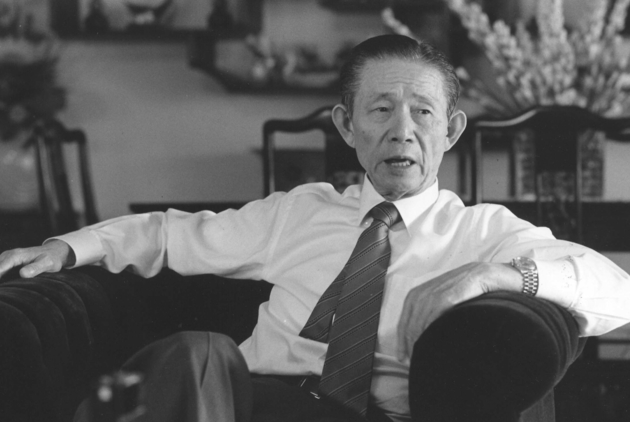Formosa Plastics’s Circular Economy Legacy: Turning Decay into Magic

Source:CW Video
At the end of November 2019, a road race was held at the old Formosa Chemicals & Fibre Corp. complex in Changhua, signaling the end of an industrial era. The complex’s main factory, which had been around for more than half a century was Formosa Plastics Group founder’s Wang Yung-ching tribute to the circular economy. But the production line has been shut down, and how this 70-hectare plot of land is used in the future could have a profound effect on Changhua residents. Here is the story of where that land has been and where it may be headed.
Views
Formosa Plastics’s Circular Economy Legacy: Turning Decay into Magic
By Kuo-chen Luweb only
When Formosa Chemicals & Fibre Corp. (FCFC) was established in 1965 and built a factory in Changhua, it was the third big company set up by the Formosa Plastics Group. Yet rather than flying under the radar, its founding represents an indelible chapter in the development of Formosa Plastics and Taiwan’s industrial sector.
Built more than half a century ago, the Changhua factory had circular economy concepts that were later extended to the Group’s sixth naphtha cracker complex. It also laid the foundation for the world-class umbrella, tire and curtain clusters that sprung up in Changhua.
FCFC Vice Chairman Hong Fu-yuan, himself a Changhua native, started at the Changhua factory 49 years ago, and next year will mark his 50th year with the company.
Established more than half a century ago, the Formosa Chemicals & Fibre Corp. factory in Changhua was Formosa Plastics’ founder Wang Yung-ching’s tribute to the circular economy. (Photo by Chien-Tong Wang/CW)
“Nobody would have imagined at the time that someone could take waste wood and Formosa Plastics’ surplus alkali production, mix them together, and end up with rayon. Wang Yung-ching is truly deserving of the ‘God of Management’ moniker,” Hong says.
Rayon has been described as artificial silk and artificial cotton. The two characters for rayon in Chinese – 嫘縈 (lei-ying) – were even taken from the inventor of silkworm cultivation – the “Goddess of Silk” Lei Zu (嫘祖) – to highlight rayon’s contribution to human society.
The standard production method for rayon when the Formosa Plastics Group was taking shape involved bathing cellulose in sodium hydroxide, and in fact cellulose fibers and sodium hydroxide (an industrial alkali also known as “caustic soda” or “lye”) were its main components. The material was then turned into fabrics approximating silk, wool and natural cotton.
Turning Your Waste into My Materials
Nan Ya Plastics Corp. (another Formosa Plastics Group company) had already been founded in 1958 to solve the problem of Formosa Plastics’ production surplus of PVC (polyvinyl chloride). Wang had opened the spigots on Formosa Plastics’ PVC production in Kaohsiung to create a plastics kingdom.
That created another problem, however. The large volume of chlorine used in PVC production resulted in a glut of industrial alkali. Hong recalls Wang thinking on a whim of taking waste wood from Taiwan’s logging industry and adding the excess alkali to that waste to create rayon. “It sounds really simple, but nobody had thought of it,” Hong says.
Starting in 1964, Wang spent a year researching the subject and looking for land, and he decided in 1965 to invest in and build a factory in Changhua.
Although the waste wood is a natural material, a chemical reaction is still needed to extract fibers through the use of alkali, explaining why FCFC needed to include the word “Chemicals” in the company’s name, according to Hong.
That also dictated the focus of Wang’s use of the more than 70-hectare plot he had in Changhua City, which he broadened into an investment concentrated on chemical fibers. The facility became an important player in the global rayon market, at one point accounting for 6.6 percent of the world’s rayon cotton capacity, ranking fourth globally.
The company then built a nylon factory in the Changhua complex that had a production process complementing that of the rayon production line. In effect, FCFC leveraged to the fullest the circular economy spirit of “taking your waste and turning it into my materials.”
When FCFC’s rayon first hit the market, it was billed as “turning decay into magic.” Perhaps the most magical part of this circular economy process was Wang taking wood waste and industrial alkali costing about US$40 per metric ton and transforming it into a product (rayon) worth US$1,200 per metric ton. That astronomical margin enabled FCFC to stand strong in Changhua for more than half a century.
Have you read?
♦ Made-in-Taiwan Biodegradable Plastic, Delivering Big for Starbucks
♦ Trade War Brings Orders for 300 Million Pairs of Socks to Changhua
♦ Formosa Plastics’ Shift to America
Origins of Formosa Biomedical Technology
The process triggered another legendary bit of magic. To take advantage of another by-product of rayon production called thenardite, a type of sodium sulfate mineral, FCFC created a “Detergent Division” to use the sodium sulfate to make laundry detergents and cleaning product materials.
It has since supplied domestic detergent vendors and produced FCFC’s own brand of laundry detergent called Taili Detergent Powder, meaning that for the past half century, a good portion of the raw materials used in Taiwan’s detergent powder came from the FCFC factory complex in Changhua.
In 2003, FCFC spun off its “cleaning agent” business group into Formosa Biomedical Technology Corp. under the direction of Sandy Wang, Wang Yung-ching’s daughter and at the time a member of the Formosa Plastics Group Administration Office.
The new enterprise got its start by marketing laundry detergent powder but gradually expanded into beauty products and cosmetics. Wang Yung-ching gave his full support to his daughter by using Formosa Biomedical care products himself, and through the company’s continued efforts, its products are now found on the shelves of almost every big department store or shopping center around Taiwan. One of its shampoos is a best-seller, with about 2 million bottles sold per year.
Over time, Formosa Biomedical has gradually built a strong business, and its journey embodies the story of circular economy practices and industrial transformation that has seen it evolve from inconspicuous twigs and sodium sulfates into beauty and care products.
At the same time, the influence of rayon and nylon on Changhua and Taiwan’s industrial sector as a whole has been far-reaching through their use in fabrics for umbrellas, tires and curtains. Changhua’s emergence at one point in time as one of the world’s leading producers of those three items was directly linked to FCFC’s building of the Changhua plant and its supply of high volumes of good-quality, low-cost fabrics.
Changhua’s Collective Olfactory Memory
To those not involved in those industries, however, FCFC’s Changhua plant represents another type of memory. Because sources of natural cellulose such as branches and twigs may contain sulfides or residual proteins that are dissolved by chemical solvents, it was not always possible in the early years of rayon production to completely prevent the emission of those substances’ odors. The same was true for acetic acid and ammonia smells created by the production of nylon.
Consequently, local residents and people traveling between northern and southern Taiwan were able to smell a slightly acidic odor in the air, one that became entrenched in the collective memory of Changhua residents. Some would even joke that when taking the train there was no need to look to see where you were; all you had to do was take a whiff of the air, and when you smelled that odor, you knew you were in Changhua.
As the Changhua facility later grew into a mega-factory with more than 10,000 workers and Taiwan no longer had enough waste wood to meet its needs, FCFC had to import wood from Indonesia. That spawned tales in Changhua of how the imported wood often hid large lizards and pythons that slithered onto Changhua’s bustling streets.
As for rumors in later years that the odor came from the complex’s coal-fired cogeneration power plant, they were not true.
By 2016, however, Changhua’s steady urban development meant that the FCFC plant, once located on the outskirts of Changhua City, was now on prime real estate with extremely strong commercial potential. Not only could the more than 70 hectares support a comprehensive development plan, but the plant’s production had been on the decline as manufacturers throughout the country relocated abroad. At the same time, voices opposed to burning coal to generate steam and power in the center of the city were on the rise.
Those forces led Changhua County Commissioner Wei Ming-ku to demand that FCFC conduct a new environmental impact assessment (EIA) for the factory before the license for the plant’s boilers, which expired in September 2016, could be renewed. That set off a stalemate between the county and the company over whether an EIA was necessary for FCFC to renew its license.
Production Line Down, but Circular Economy Vision still Alive
In the end, the cogeneration plant was shut down, and FCFC responded by filing a national compensation suit against the Changhua County government. Without steam to supply to nylon and rayon production, the fate of the FCFC factory seemed sealed. Over the past three years, over 1,500 workers have been forced to transfer to other Formosa Plastics Group facilities or take early retirement.
Formosa Biomedical, on the other hand, has emerged as the main pillar of the Changhua complex. The company that once made laundry detergent powder with the by-product of rayon production has converted its plant into a tourism factory and wellness park, even working with Chang Gung Memorial Hospital to introduce preventive medicine services.
Formosa Plastics held a family road run at the FCFC factory complex in Changhua on Nov. 24, 2019, signaling the end of the complex’s industrial journey. (Source: Formosa Plastics)
As part of its new look, the FCFC complex also held a road race this year, and, a new development plan for the 70-hectare plot has also taken shape. It will involve not only additional investment in Formosa Biomedical but also the construction of residential housing, Sandy Wang has said, an indication that the era of Wang Yung-ching’s use of forest waste to create a circular economy legend but also a smell familiar to Changhua area residents has come to an end.
One thing will not change, however. Sandy Wang said a plastic waste recycling pilot project will be established at the FCFC Changhua plant location. Residents will be able to bring their unwanted plastic to the site and exchange it for points that can be redeemed for Formosa Biomedical products, helping solve the problem of waste plastic being disposed of recklessly and giving new value to recycling.
Thus, while the FCFC plant complex that Changhua residents have lived with for more than half a century may be changing, Wang Yung-ching’s spirit of getting the maximum value from every resource and frowning on waste is set to live on in the city.
【More on Wang Yung-ching】
♦ Taiwan's Most Admired Entrepreneurs
♦ A Life Ends, the Legend Lives On
♦ Wang Yung-ching's Living Legacy
Translated by Luke Sabatier
Edited by Sharon Tseng












